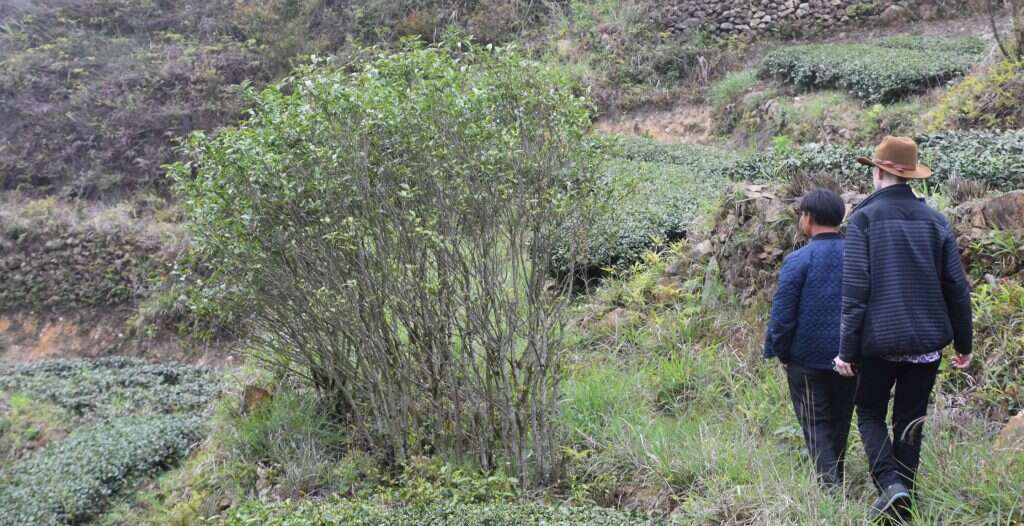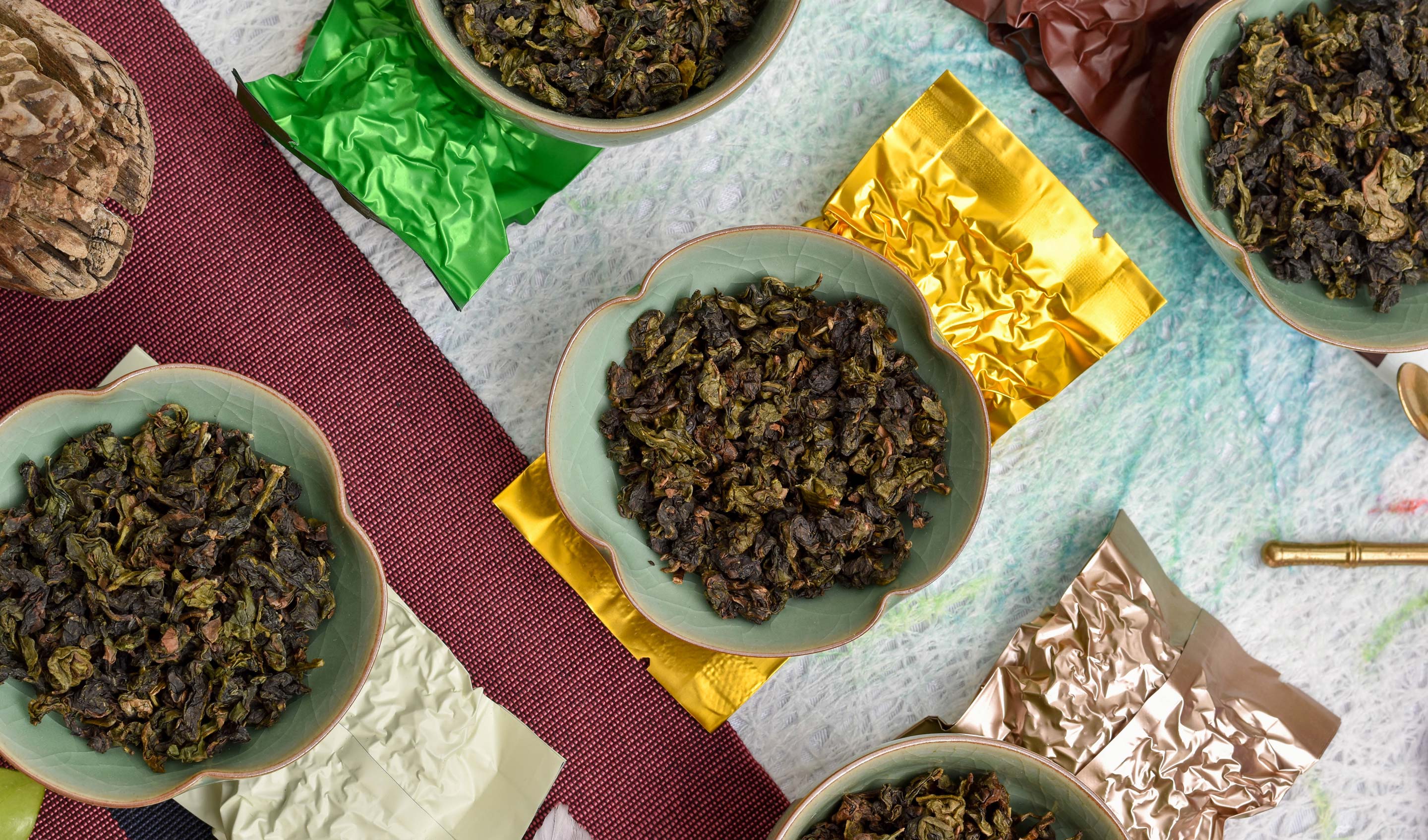While Anxi is world-famous for Tieguanyin, Master Zhang cultivates a huge variety of tea plants in the interest of increased biodiversity and to help him research the cultivars most suited to his style of zero-impact farming. This requires him to preserve native tree cover, ensure that his land and anyone else’s upstream is free of pesticides and fertilizers, and refrain from redirecting water to his fields. This beyond-organic agriculture yields deeply complex tea because the flavor and texture that we love in tea is caused primarily by the plant producing compounds to fight off insects and survive. Tea that has to work hard tastes more complex because it puts up a greater defense.
Part of Master Zhang’s efforts at developing a robust and biodiverse tea preserve is to cultivate as many different varietals as possible. Some are native to Daping, while others are transplants from other regions where Master Zhang has worked and studied to build his knowledge over a lifetime
We’ll be visiting Master Zhang this spring to be there to learn more from him about oolong craftsmanship, but when he sent us five almost unheard of varietals in Anxi, we wanted to at the very least review all of our footage and interviews to look for inspiration before tasting, so this tasting journal starts with a quote from Master Zhang describing his process:

 Click
to watch
Click
to watch
“The process of making tieguanyin is bringing the tea back and forth between withered and alive.
Why do you have to do this back and forth?
The process of bringing it back from the brink eliminates bitterness and astringencyFirst, you pick the tea leaves, and they are firm and hard.
You let them wither out in the sun, and they “die” – they become soft.
Then you bring them in and spread them out, and they slowly come back to life.When they are alive again, you shake the leaves.
When you tumble them, they come back.After tumbling, the leaves need to be spread out, because after tumbling, the tea is alive. It coaxes the moisture in the stems into the outer part of the leaves. When the moisture goes out to the leaves, the tea becomes firm again, alive again. Then you let it sit until the moisture evaporates and the leaves “die” again.
So when you think the moisture has gone down, you tumble it a second time.
After the second time – the second time, you tumble it more.
The third time can be even stronger.By the time you get to the fourth or fifth tumbling, you have to watch closely. You have to check the stem moisture. When it is almost there, you have to continously check while tumbling vigorously until the moisture content is right.
Then you can heat-fix the tea.
Usually, it takes from picking one day to fixing the next day…When you’re working in tea, you have to work according to the tea. You have to constantly think of the tea.
First, you have to think about the weather.
Second, you have to think about the tea leaves themselves.
You have to work together with the tea.
Look to the sky and look to the leaves.This is critical.
There isn’t one rigid process you can follow.”
Master Zhang’s lifetime of experience gives him an intuitive sense of how to bring out the best in each tea, even when they are cultivars like Jin Suo Shi or Liao Mian Ji where there is little to no local tradition to lean against.
With a reminder of how lucky we are to get to taste tea form such a master craftsman, let’s brew up our five newest and most limited additions to the Master Zhang Collection!
Dark Roast Liao Mian Ji
This tea took us completely off-guard. We expected the typical floral and creamy balance that elegant Anxi Oolongs are famous for, but instead we were blown-away by deep dessert-like flavors. Right from the first smell of the wet leaf, it was clear that this tea was packed with caramel and spice.
The early infusions were full of cinnamon, nutmeg and sweet rum cake. The texture and body of this tea was packed full of deep creamy weight, perfectly rounded and solid. The interesting thing about these deep cream and caramel notes is that they weren’t coming from a dark roast flavor. Master Zhang did do a long full roast on this tea, but the caramel here didn’t have the flavor of caramelized tea sugars, but rather feels inherent and perfectly integrated into what the tea is offering naturally. This becomes really clear when the Liao Mian Ji is compared to the other four teas Master Zhang sent with the same exact roast, none of which have caramel tones.
In very late steepings, the caramel theme is accented with candied orange, and subtle warm florals for a tremendous complexity.


The initial aroma of the Xiao Ye Huang Dan reminded us of deep cozy mulled wine. With this aroma, we expected a dark flavor to follow, but Master Zhang’s masterful and slow handling of the leaves while developing their aroma has brought out Xiao Ye Huang Dan’s iconic flavor profile.
We were immediately hit with juicy kiwi and satsuma mandarin oranges in the early steepings, a juicy mouth-watering sensation that quickly weaves into the minerality on display for a sparkling aftertaste. In later steepings, deeper hazelnut complexity starts building to bolster the whole profile. Warm marigold florals round out the experience. As the flavor and texture starts to build up, it quickly becomes apparent what a powerful tea this is, full of textural sparkle that make it thrilling to sip.


Dark Roast Anxi Ba Xian
We’ve been asking Master Zhang about his Ba Xian every time we visit and walk by the stand of tall, wild-looking bushes that he transplanted years ago from Fenghuang. We first tried Ba Xian with Master Zhang’s colleague, the famous Huang Ruiguang at his family workshop in Wudongshan and fell in love with its deep complexity and cooling electric aftersensation called yun. This year, Master Zhang decided to actually harvest his experimental Ba Xian bushes and carefully hand-finish them to provide a counterpoint to Wudongshan’s Ba Xian.

We were utterly blown away! I’ll admit, we thought about not releasing this tea and keeping it all to ourselves, but Master Zhang didn’t send us this precious little harvest to hoard – he wanted it shared.
The initial aromatics were full of rich sweet semolina, deep spice, and tart dark fruit. The first sips revealed a dominant electrical yun, the indescribable sparkle of the finest teas. The flavor was actually very woody like Fenghuang Dancong, but rounded out by a luscious vanilla cream and deep dried cherry aroma. The flavor and aftertaste kept building over every sip with a numbing fennel and anise quality to complement juicy sweet honey and pervasive yun.


Dark Roast Jin Suoshi
This fascinating tea brought together deep herbaceous rosemary spice and sweet juicy fruit flavors with an effortless elegance. The first aromatics of the wet leaf were full of coriander, pomegranate and rosemary. Yet the early steepings build into a juicy luscious and floral lychee sweetness with a tart and aromatic touch of dried strawberry.
The way this tea builds on its sweetness reminds us of monksfruit or licorice root, where the sweetness hits the back of the throat in an almost numbing way. As the tea continues to build up, it reveals rich vanilla and violet undertones along with creamy honeyed notes and toasted almond. It reminded us most closely of the floral creamy combination of certain white wines of the Northern Rhone like Condrieu in its commanding and confidant profile.


Dark Roast Ming Xiang Yun
This tea was all about balance and refinement. While some Anxi oolongs go off the deep end in fruit or florals, this tea was rounded out to engage every part of the palate. The first sips build up a satisfying and elegant sparkling limestone minerality, a base for violet and crocus florals, lingering fennel aftertaste and cocoa cream.
The chocolate notes were particularly unexpected, but they acted as a central unifying theme tying together pine and cedar cooling sensations with rich warm vanilla all the way on the other side of the flavor spectrum. The result felt like a deliberate and well-considered composition that shows off Master Zhang’s craftsmanship, the rocky terroir of Daping, and the unique iconic flavors of the cultivar.


 How To
How To Myths & Legends
Myths & Legends Travelogue
Travelogue Tasting Journal
Tasting Journal Talking Shop
Talking Shop Tea 101
Tea 101 Watch
Watch Teaware
Teaware News
News

Leave a Reply